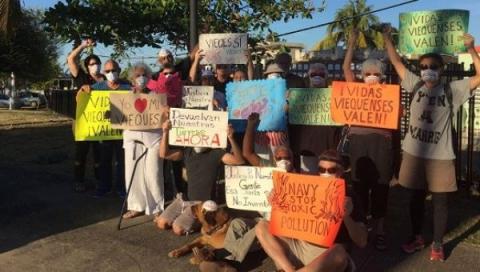Residents in Vieques, Puerto Rico protested in late July against the United States' continued detonation of toxic materials in direct violation of the agreement reached in 2003 that prohibited any more bombing on the island.
Myrna Pagan, spokesperson of “Vidas Viequenses Valen” or “Vieques Lives Matter,” reported a round of detonations from the former U.S. Navy military site and announced in a press release Saturday the organization’s plans to hold a protest at 5:00 p.m. Monday outside the U.S. Navy’s Restoration Advisory Council building.
“After six decades of bombardment and contamination, this town rises up to denounce this practice and to demand the use of existing alternatives for the cleaning of our lands and sea,” she stated.
On July 25 and 27, two separate explosions shook the island, releasing poisonous chemicals into the air, 300 units closer to the community’s border and its 9,000 residents.
“Smoke columns were seen from our windows and workplaces spreading toxic gas waste into the air from the explosions caused by the (U.S.) Navy … It was one of the strongest explosions we’ve ever felt, but it’s our daily bread,” Pagan said.
“The morning of the detonation I could not breathe,” said Vidas Viequenses Valen member, Kiany Connelly. “My dad told me that since I was little when the (U.S.) Navy was carrying out maneuvers, they gave me these asthma attacks.”
The community was never notified of the U.S. Navy’s plans to detonate nor advised of any precautionary methods to take for their health and welfare. Pagan told the press she had informed the U.S. Environmental Protection Agency, the government office charged with protecting the environment and health of Vieques since all of Puerto Rico remains a colony of the United States.
“If it weren’t for my call, I don’t know, they would leave us without information. They destroy the artillery and they do not allow us to protect ourselves from the harmful effects,” she said.
According to the U.S. Government Accountability Office, this is only the beginning. The military personnel estimates a remaining 505,302 tons of ammunition scheduled to be denotated in the coming years.
Since the 1940s, the U.S. Navy used a large part of Vieques as a weapons-testing ground and firing range, detonating bombs and experimenting with chemicals, from napalm to Agent Orange and depleted uranium. The military abandoned the base in 2003 after an encampment on the island garnered national and international support.
The remains of 60 years of military exercises contaminating the environment, with empty promises of a US$220 million cleanup project has left the residents to struggle with the effects.
"The cleaning of Vieques is a farce, nothing is being cleaned," said Pagan, who will lead Monday's protest.
Ismael Guadalupe, a leader in the decades-long struggle to get the U.S. Navy out of Vieques, explained that if the military destroys the toxic materials at all, it’s through open burning, open detonation or incineration.
"Some of the chemicals go through the air and disperse into the environment, polluting the land and water, and damaging the health of nearby communities," he said.
A study conducted by the University of Toronto, Canada, earlier this year confirmed the serious health defects to the Vieques population from the chemical weapons.


Spread the word